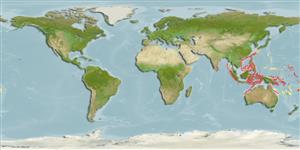Environment: milieu / climate zone / depth range / distribution range
Écologie
marin bathydémersal; profondeur 200 - 270 m (Ref. 9494). Deep-water
Western Central Pacific: Philippines, Indonesia and Australia.
Taille / Poids / Âge
Maturity: Lm ? range ? - ? cm
Max length : 22.0 cm SL mâle / non sexé; (Ref. 311)
Épines dorsales (Total) : 0; Rayons mous dorsaux (Total) : 67 - 70; Épines anales: 0; Rayons mous anaux: 50 - 53. Color of preserved specimens tan to dark grey on the ocular side; tan or whitish on the blind side. Pectoral fin rays 11-13 on ocular side; 11-12 on blind side. Pelvic fin of ocular side with black spot and shorter than that on the blind side. Gill rakers elongate and pointed. 1st interhemal spine stout.
Inhabits mud and sand bottoms (Ref. 9774). Feeds on crustaceans and other benthic invertebrates (Ref. 9774).
Life cycle and mating behavior
Maturité | Reproduction | Frai | Œufs | Fécondité | Larves
Distinct pairing (Ref. 205).
Hensley, D.A. and K. Amaoka, 1989. A redescription of Pseudorhombus megalops, with comments on Cephalopsetta ventrocellata (Osteichthyes: Pleuronectiformes: Paralichthyidae). Proc. Biol. Soc. Wash. 102(3):577-585. (Ref. 2688)
Statut dans la liste rouge de l'IUCN (Ref. 130435: Version 2024-1)
Menace pour l'homme
Harmless
Utilisations par l'homme
Outils
Articles particuliers
Télécharger en XML
Sources Internet
Estimates based on models
Preferred temperature (Ref.
123201): 11.7 - 20.8, mean 15 °C (based on 37 cells).
Phylogenetic diversity index (Ref.
82804): PD
50 = 0.5000 [Uniqueness, from 0.5 = low to 2.0 = high].
Bayesian length-weight: a=0.00724 (0.00338 - 0.01553), b=3.17 (3.00 - 3.34), in cm total length, based on LWR estimates for this Genus-body shape (Ref.
93245).
Niveau trophique (Ref.
69278): 3.5 ±0.44 se; based on food items.
Résilience (Ref.
120179): Haut, temps minimum de doublement de population inférieur à 15 mois (Preliminary K or Fecundity.).
Fishing Vulnerability (Ref.
59153): Low vulnerability (17 of 100).
